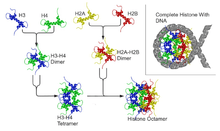Anti-histone antibodies
Anti-histone antibodies are autoantibodies that are a subset of the anti-nuclear antibody family, which specifically target histone protein subunits or histone complexes.[1] They were first reported by Henry Kunkel, H.R. Holman, and H.R.G. Dreicher in their studies of cellular causes of lupus erythematosus in 1959-60.[2][3] Today, anti-histone antibodies are still used as a marker for systemic lupus erythematosus, but are also implicated in other autoimmune diseases like Sjogren's Syndrome, dermatomyositis, or rheumatoid arthritis.[4][5] Anti-histone antibodies can be used as a marker for drug-induced lupus.
Specificity

Anti-histone antibodies target 5 major classes of histone protein subunits: H1, H2A, H2B, H3, and H4.[6] Anti-histone antibodies are diverse, so aside from targeting the protein subunits, different antibodies may also be specific for different complexes, including the H2A-H2B dimer or the H3-H4 tetramer. There is evidence that IgG and IgM anti-histone antibodies produced as a result of different drug exposures are specific to epitopes of different histone complexes.[7] Highly modified histones have been shown to prompt a greater immune response.[8]
Detecting antibodies
Anti-Histone antibodies can be clinically detected using an ELISA assay. A blood sample is required for the test.[9][5]
Indirect Immunofluorescence can also be used to detect anti-histone antibodies. Homogeneous, diffuse staining indicates the presence of anti-histone antibodies, chromatin, and some double-stranded DNA.[4]
Implications in disease
Ninety-six percent of patients with lupus induced by procainamide will have a positive test for anti-histone antibodies, and 100% of patients whose lupus was induced by penicillamine, isoniazid, or methyldopa will have a positive test for anti-histone antibodies. In 70% of patients with Rheumatoid arthritis, Felty's syndrome, Sjogren's Syndrome, systemic sclerosis, and primary biliary cirrhosis, anti-histone antibodies are present. Anti-histone antibodies may also be present in Alzheimer's disease and dementia patients.[6]
A value of greater than 1.5 units relative to a control serum is considered a positive ELISA test for the anti-histone antibodies. Patients with Drug-Induced Lupus Erythematosus typically have positive tests for anti-histone antibodies but do not have indications for Anti-dsDNA antibodies. Patients with idiopathic Systemic Lupus Erythematosus have both types of autoantibodies present in their blood. Thus, this test can be useful in distinguishing these two illnesses.[9]
References
- Muller, Sylviane (2014). Chapter 23 - Histone Autoantibodies, In Autoantibodies (Third ed.). San Diego, CA. p. 195. doi:10.1016/B978-0-444-56378-1.00023-X. ISBN 9780444563781.
- Holman, Henry R.; Deicher, H.R.G.; Kunkel, H.G. (July 1959). "The L.E. Cell and L.E. Serum Factors". Bulletin of the New York Academy of Medicine. 35 (7): 409–418. PMC 1806184.
- Holman, H.R.; Deicher, H.R.G.; Kunkel, H.G. (January 1, 1960). Chapter 20. Multiple "Autoantibodies" to Cell Constituents in Systematic Lupus Erythematosus. In: Ciba Foundation Symposium - Cellular Aspects of Immunity. Chichester, UK: John Wiley & Sons. pp. 429–449. doi:10.1002/9780470719169.ch20.
- Kumar, Vinay; Abbas, Abul; Aster, Jon (2018). Robbins Basic Pathology (10 ed.). Philadelphia, PA: Elsevier. pp. 150–157. ISBN 978-0-323-35317-5.
- Inova Diagnostics. "Quanta Lite Histone". Inova Diagnostics a Werfen Company. Retrieved 8 February 2018.
- Cozzani, Emanuele; Drosera, Massimo; Gasparini, Giulla; Parodi, Aurora (6 February 2014). "Serology of Lupus Erythematosus: Correlation between Immunopathological Features and Clinical Aspects". Autoimmune Diseases. doi:10.1155/2014/321359. PMC 3932647.
- Burlingame, Rufus; Rubin, Robert (August 1991). "Drug-induced anti-histone autoantibodies display two patterns of reactivity with substructures of chromatin". Journal of Clinical Investigation. 88: 680–690. doi:10.1172/JCI115353. PMC 295413.
- Dema, Barbara; Charles, Nicolas (4 January 2016). "Autoantibodies in SLE: Specificities, Isotypes, and Receptors". Antibodies. 1 (5). doi:10.3390/antib5010002.
- "HIS - Clinical: Histone Autoantibodies, Serum". Mayo Medical Laboratories. Retrieved 2018-08-04.